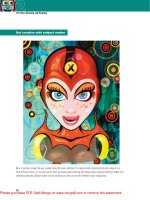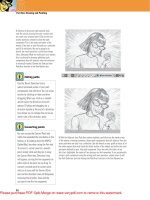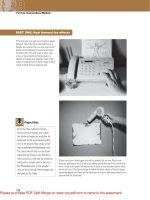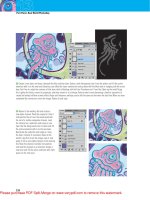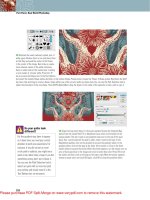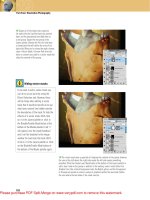Creative Photoshop: Digital Illustration and Art Techniques Photoshop Cs4- P7
Bạn đang xem bản rút gọn của tài liệu. Xem và tải ngay bản đầy đủ của tài liệu tại đây (6.54 MB, 50 trang )
288
Part Three: Real World Photoshop
15
39 Duplicate the newly reduced, copied, pair of
paths again. Reduce them in size and place them
so that they surround the center of the flower
in the center of the image. Next, make a couple
more reduced copies of the paths and place
them on either side of this central pair, creating
a nice cluster of circular paths. Press the “ U ”
key to access the Ellipse tool . In the Tool Options
bar, select the Custom Shape option. And then, in the Custom Shape Preset picker, choose the Flower 5 Shape preset. Hold down the Shift
key, then click and drag to create a flower shape within one of the circular paths as shown here. You can use the Path Selection tool to
adjust the placement of the new shape. Then, Alt(PC)/Option(Mac)-drag the shape to the inside of the opposite circular path to copy it.
40 Target the top smart object in the Layers palette. Choose the Gradient Map
option from the Create New Fill or Adjustment Layer menu at the bottom of the
Layers palette. This will create a new gradient map layer at the top of the layer
stack. Your current path will be used to add a vector mask to the layer. In the
Adjustments palette, click on the gradient to access the gradient editor. In the
gradient editor, click on the stop at the lower left to select it. Click on the Color
swatch below to access the picker. When the picker appears, run the mouse over an
area of dark gray-blue in the image and click to select that color. Press OK to exit
the picker, and then click on the stop at the lower right. When the picker appears,
choose a taupe color and click OK. Again, click OK to close the gradient editor.
For the gradient map layer to appear
as it does here, you must pay careful
attention to path area operations. For
instance, if you did not set an inner
circle path to subtract, you might see a
solid circle rather than a hoop. If you did
something wrong, don’t worry about it.
You can use the Path Selection tool to
select any path with an incorrect path
area setting and simply reset it in the
Tool Options bar as necessary.
Do your paths look
different?
Please purchase PDF Split-Merge on www.verypdf.com to remove this watermark.
289
Chapter 15: In and Out of Photoshop
15
41 Now select the Stroke option from the Add a Layer Style menu at the bottom of the Layers palette.
When the Stroke options appear, click on the Color swatch and then choose a white color from the
picker. Set the size at 3 pixels and click OK to add a thin white stroke around the visible areas of your
gradient map layer. Duplicate the layer and disable the visibility of the original layer in the Layers
palette — this will avoid confusion. Ensure that your duplicate layer is targeted in the Layers palette,
not the original. Use the Path Selection tool to select the flowers and all other path components
except for those that make up the two central circles. Press the Delete key to remove all selected path
components from this layer’s mask.
42 Select all of the remaining path components
on the layer’s mask and then click on the Align
Vertical Centers and the Align Horizontal Centers
buttons in the Tool Options bar. Then drag all of
the selected, aligned path components up to the
top area of the canvas. Now, drag the current
layer beneath all of the skull smart objects
in the Layers palette. Enable the visibility of
your original gradient map layer once again.
Moving things up and down within the Layers
palette is essential when it comes to building
a composition like this. However, you need to
pay attention to everything on the canvas as
you do this. Remember, not too long ago, when
we duplicated the red trees group and moved it
up in the Layers hierarchy, one thing that went
unnoticed as a result of this procedure was
that it obscured the dark blue grass along the
bottom of the canvas . To remedy this, select the
dark trees group in the Layers palette and drag
it above the red trees group copy.
Please purchase PDF Split-Merge on www.verypdf.com to remove this watermark.
290
Part Three: Real World Photoshop
15
43 Use the Eyedropper to click on an area of red within the image, sampling it as
the current foreground color. Select the Ellipse tool from the toolbar. In the Tool
Options bar, click the button at the left to ensure that you’ll be creating a shape
layer with this tool. Target the top layer in the Layers palette to ensure that your
new layer appears above it in the hierarchy. Hold down the Shift key, then click
and drag to create a circular shape layer. You’ll immediately notice that the stroke
effect we used previously is automatically added to the new layer as well. This
saves us the trouble of copying the effect to our new layer. Hold down the Alt(PC)/
Option(Mac) and Shift keys while you draw a smaller circle inside the original
circle on this layer. Select both shape components with the Path Selection tool and
then align the centers vertically in the Tool Options bar.
44 While the two shape components are selected, click on the
Combine button in the Tool Options bar to combine them into a
single shape. The advantage of this is that we can select the entire shape by clicking on any line segment. We don’t need to click on
one component and then Shift-click on the other now that the components are combined. Use the Path Selection tool to click on the
shape and then Alt(PC)/Option(Mac)-drag it to another region of the canvas to duplicate it within the same shape layer. Repeat this a
number of times to scatter red hoops around the top of the canvas. Select individual shape instances and alter the size of them via
Free-Transform.
Please purchase PDF Split-Merge on www.verypdf.com to remove this watermark.
291
Chapter 15: In and Out of Photoshop
15
45 Select the Ellipse tool and ensure that it is set to create a new shape layer in the Tool Options
bar. Create a new shape layer that contains a single circle. Position it within the center of the
gradient map hoops at the top of the composition. Use the Eyedropper to sample a dark gray
color from the image and then type Alt(PC)/Option(Mac)-Delete to fill the shape layer with the new
foreground color.
46 Select the Custom Shape tool. Unless you’ve changed something since you used the tool last, the Flower 5 preset will be selected
in the Custom Shape picker in the Tool Options bar. Ensure that the tool is set to create a new shape layer. The Chain-Link button will be
enabled in the Tool Options bar; click on it to disable it. This ensures that any changes you make will affect your new layer, not the layer
currently targeted in the Layers palette. Click on the Color swatch in the Tool Options bar and select a desaturated gray color from the
picker. After that, click and drag on the canvas to create a new shape layer with a flower on it. Press the Shift key while you’re dragging
to constrain the flower’s aspect ratio. Ensure that you do not press the Shift key before you drag or your flower shape will be added to
the previous shape layer. We want this flower to be on a separate shape layer. Use the Move tool to place the flower on top of the circle
you created previously. Use Free-Transform to adjust the size of the shape if necessary. In the Layers palette, double-click on the stroke
effect attached to this layer. Change the stroke color to the same red you’ve been using in the image all along.
Please purchase PDF Split-Merge on www.verypdf.com to remove this watermark.
292
Part Three: Real World Photoshop
15
47 Create a couple of duplicates of your flower
shape within the same layer. Place them lower
down, and on either side of the central elements
of the image. Select the Ellipse tool and create
another new shape layer that contains a small
circle. Change the color of this layer to the
same light yellow color used within the skulls.
Create numerous duplicates of this shape within
the layer and scatter them around the top half
of the canvas and on the background regions on
either side of the skulls. Use Free-Transform to
adjust the individual shapes as required.
48 Now, depending upon the colors you’ve been
using, you may or may not feel that the image
needs a bit of tonal enhancement. I thought that
my version needed a slight tweak, so I created a
new levels adjustment layer and dragged the left
and right input levels sliders toward the center
of the histogram. This increased the contrast a
little overall, giving the image more impact when
printed. Take a moment to organize the contents
of the Layers palette into logical groups wherever
you can. This file is constructed in a way that
lends itself to further editing. Feel free to tweak
color fills, gradient, or alter smart objects at will.
A well-organized Layers palette will make it much
easier to perform desired edits at a later date.
Please purchase PDF Split-Merge on www.verypdf.com to remove this watermark.
293
Chapter 15: In and Out of Photoshop
15
Other things to consider
If drawing isn’t your thing, there is certainly no end to the resources out there that lend themselves to this technique. In
this image, I used an existing ancient anatomical drawing instead of creating my own skeleton. As you can see, the overall
feel remains quite similar. Also, shape layers can be used to create main visual components. Here, I created some more
elaborate shapes via the Pen tool to represent wings. And finally, solid color layers are very useful; however, if you alter
the blending mode and then use a real-world material like a watercolor painting in behind, it can give the image a more
organic feel.
Please purchase PDF Split-Merge on www.verypdf.com to remove this watermark.
This page intentionally left blank
Please purchase PDF Split-Merge on www.verypdf.com to remove this watermark.
PART FOUR
Illustrative
Photography
Please purchase PDF Split-Merge on www.verypdf.com to remove this watermark.
Please purchase PDF Split-Merge on www.verypdf.com to remove this watermark.
297
Chapter 16: Creature Architecture
16
Creature
Architecture
Chapter 16
L
ooking at this beautiful creature before you, it is difficult to imagine that it is nothing
more than a simple model shot combined with various photographs of stone textures
and architectural details. In a composition like this, the images provide the raw
materials, but it is the Photoshop process that allows you to dissolv
e the boundary
between photographic collage an
d stunning illustration. Things as basic as blending modes,
layer masks, and layer groups are much more powerful than they seem. When features are used
together as a means to an end rather than on their own, the resulting imagery is always much
more than the sum of its parts.
The process of creating an image like this may seem daunting at first, but once you get
started, the logic reveals itself and you will find yourself perfecting this stacking technique until
it comes naturally. Here, I’ve decided to make a beautiful stone alien by adding snapshots of
architectural details to her f
ace. Howe
ver, as is evident in the showcase images at the end of this
chapter, this illustrative effect can be achieved with anything, it doesn’t have to be stone details,
it can be leaves, or whatever you like.
With the exception of channel usage, there is a bit of everything in this
chapter. In places you’ll be required to create paths. In others you’ll
perform a number of layer creation, masking, and grouping tactics. You
will duplicate things, fl ip them around, place groups within groups, and
so on. No single aspect of this project is extremely complicated; however,
it is the abundance of things you must do that may prove taxing to
inexperienced users.
Please purchase PDF Split-Merge on www.verypdf.com to remove this watermark.
298
Part Four: Illustrative Photography
16
What you’ll learn in this chapter
Creative Techniques and Working Methods
Stacking and duplication
As is often the case in Photoshop, something vast and complicated in appearance is
merely the result of repeating an integral procedure over and over again. In this chapter,
you’ll learn how to stack up duplicate layers, alter the blending modes of each, and place
them in masked groups. It is very important to remember that groups, like layers, can be
duplicated as well. Duplicated groups, like individual layers, can be horizontally flipped
and this will allow you to duplicate portions of the image so that you can create both
sides of the face with mirror-like precision. And although in this chapter I’ll explain in
detail, numerous ways to finesse your imagery as well as work with color and texture,
layer stacking and duplication is essentially the nuts and bolts of what we’re doing here.
Visualization and implementation
Apart from the instructional benefits of this chapter, it is also my hope that you will
walk away from this with a heightened awareness of your environment. And by that I
mean that you will begin to view everything around you as a resource for your artwork.
Ideally, you’ll develop a feel for which sections of imagery are useful for specific
tasks in future projects. Also, it is my hope that you’ll be able to visually dissect the
world around you at the planning and gathering stages for further projects. Once you
have an idea of what you want to achieve, you’ll be well equipped to spot the potential
in anything. Use my methods here as your guide while photographing, isolating
components within the images, and then finally incorporating those components in
a natural way into your composition. Here, you’ll notice that the piece used over the
eyebrow is a shape suited to this area. The same principle applies to the cheek detail
and even the crown on her head. Knowing just what to capture, and where to put it, is a
skill that will come effortlessly with experience.
Photoshop Tools, Features, and Functions
Lighten mode
Using this layer blending mode is immensely beneficial while you paint over areas of skin to
smooth them out. It prevents accidentally sampled dark colors from appearing against the
background image.
Flip horizontal
This Transform option is an essential tool in saving time as well as providing perfect
symmetry.
Fill layers
A subtle combination of fill layers near the end has a dramatic impact on the overall feel of
the image.
Please purchase PDF Split-Merge on www.verypdf.com to remove this watermark.
299
Chapter 16: Creature Architecture
16
When you look at this group of photographs, you may
find it difficult to envision the results. But rest assured,
the stunning image at the beginning of this chapter is
nothing more than the product of very basic photographs.
Be warned however, as you read through the following
pages and develop an understanding of the process, it
may change the way you view the world surrounding you.
One hazardous side effect of producing photographic
illustrations is that you’ll tend to always be scanning
everything you see, trying to find something useful for
your next composition. So proceed at your own risk, and
don’t say I didn’t warn you first.
Please purchase PDF Split-Merge on www.verypdf.com to remove this watermark.
300
Part Four: Illustrative Photography
16
PART ONE: Preparing the face
1 The first thing you need to do is open up the face.jpg
file. This file provides the basic starting point for the
photographic illustration. In the Layers palette, click on
the background layer and drag it onto the Create a New
Layer button at the bottom of the palette to duplicate
it. Target the duplicate layer in the Layers palette and
then choose Edit Ͼ Transform Ͼ Flip Horizontal from the
menu to flip the contents of the duplicate layer. Use the
Rectangular Marquee tool to draw a selection around
the left half of her face on this layer.
2 Press the Delete key to remove the selected area from the duplicate layer.
Alr
eady, things are beginning to appear a little str
ange as a result of reflecting
half of her face. Deactivate the current selection and then click on the Add Layer
Mask button at the bottom of the Layers palette to add a mask to the duplicate layer.
Select the Gradient tool, and in the Tool Options bar, choose the Radial Gradient
option. From the list of Gradient presets, choose the Foreground to Transparent
Gradient preset. Click on your layer mask in the Layers palette to ensure that it is
targeted.
Project files
All of the files needed to follow
along with this chapter and create
the featured image are available for
download on the accompanying Web
site in the project files section. Visit
www.creativephotoshopthebook.com.
Duplicating layers
There is more than one way to duplicate
a layer in Photoshop. You already know
that you can drag a layer onto the
Create a New Layer button at the bottom
of the palette, but there are a few other
ways to do it. With your layer targeted,
simply choose the Duplicate Layer
option from either the Layers Palette
menu or the Layer menu in the Menu
bar. Another method is to hold down the
Control key(Mac), or right-click(PC)
on your targeted layer in the Layers
palette. A pop-up menu will appear that
offers up the Duplicate Layer command
here as well.
Please purchase PDF Split-Merge on www.verypdf.com to remove this watermark.
301
Chapter 16: Creature Architecture
16
3 Set the current foreground color to black, then click and drag
on the canvas to add a gradient within the layer mask. Start with
the nose area, you’ll immediately see the hard line disappear as
you introduce a gradient over the top of it. Also, as you introduce
gradients into the mask, you’ll see them appear on the layer mask
thumbnail in the Layers palette.
Using the Gradient tool within your new layer mask
You need to think beyond a single gradient when it comes to creating a gentle mask effect for an image like this.
1
If you find that you have masked
out areas by accident because you
have created a gradient that is too
large within your mask, worry not,
there is a way to remedy this. First,
set the foreground color to white.
2
Now, using white, click and drag to unmask
areas of the layer, blending them back into
visibility. The key to successful masking is to
add and remove as needed, drawing gradients
and switching back and forth between black and
white as required.
3
Create large and small gradients as required, masking and unmasking, until you’ve
removed the hard line dividing the two halves of her face. Also, for gentle results, try
reducing the opacity of the gradient in the Tool Options bar as you use it.
Please purchase PDF Split-Merge on www.verypdf.com to remove this watermark.
302
Part Four: Illustrative Photography
16
PART TWO: Creating luminous eyes
4 When you’re happy with the results of the mask, choose
Layer Ͼ Flatten Image from the menu to merge the layers. Now we’re
going to add a blur effect around the edges. Duplicate the newly
merged background layer in the Layers palette using the layer
duplication method of your choice. With the duplicate layer targeted
in the Layers palette, choose Filter Ͼ BlurϾ Gaussian Blur from the
menu. Enter a radius value that has a significant impact. This will
vary depending upon the resolution you’re working at. Click OK to
apply the blur effect to your duplicate layer.
5 Add a layer mask to your blurred layer and select the Gradient tool. If you haven’t
alter
ed any of the tool settings,
they will remain the same wa
y you left them.
With the foreground color set to black, the Gradient preset set to foreground to
transparent, and the Radial option enabled, click and drag from the center of her
face outward to reveal the image underneath the layer that remains in focus. Add
gradients to the mask, in black and white as required, masking and unmasking the
contents of the layer, until her face is in focus and the surrounding areas are not.
Setting and swapping
colors
When editing the content of a
layer mask, you’ll generally want to
use either black or white, if your
foreground and background colors
are showing up as shades of gray you
can quickly set them to their default
black-and-white state by pressing the
“ d ” key on your keyboard. By default,
white is the foreground color and
black is the background color when a
mask is active. However, if you want to
switch them quickly, just press the “ x ”
key on your keyboard. You can swap the
foreground and background colors as
often as you like by simply hitting the
“ x ” key.
Please purchase PDF Split-Merge on www.verypdf.com to remove this watermark.
303
Chapter 16: Creature Architecture
16
6 When you’re satisfied with the mask, flatten the image and then select
the Pen tool. In the Tool Options bar, ensure that the Pen is set to create
paths and not shape layers. Also ensure that the Add to Path Area option is
selected. Use the Pen tool to carefully trace the contour of her iris on the
left side of the image. Create a closed path component by returning to the
starting point. Now, in the Paths palette, generate a selection from the path
by Control-clicking(PC)/Command-clicking(Mac) on the path thumbnail.
Building up luminous eye effects
Use a series of different layers to begin stacking up the luminous eye effect that gives our alien her otherworldly stare.
1
Choose Layer Ͼ New Ͼ Layer
Via Copy from the menu to
create a new layer containing
the selection contents. Choose
Image Ͼ Adjustments Ͼ Levels from
the menu and drag the center input
slider to the left to lighten the iris
midtones. Drag the left slider toward
the right a little.
2
Control(PC)/Command(Mac)-click
your layer thumbnail to generate
a selection from it. Then click on
the Hue/Saturation button in the
Adjustments palette to create a new
hue/saturation adjustment layer.
Enable the Colorize option and then
manipulate the sliders to give the iris
a bright blue hue. Select the Magic
Wand tool when finished.
3
Click on a blue area of the
iris to generate a selection
from it. Create a new layer and
then add a white to transparent
radial gradient inside the active
selection on your new layer.
Change the layer blending mode
to overlay.
Please purchase PDF Split-Merge on www.verypdf.com to remove this watermark.
304
Part Four: Illustrative Photography
16
7 Duplicate the top layer and change the blending mode to
screen; this adds some white into the iris. Reduce the opacity of
the top layer to 40% or so. Now, go ahead and add layer masks to
the top two layers and use the aforementioned gradient methods
to blend any hard edges or mask out any unwanted areas from the individual layers. Target the top layer and then, while holding down
the Shift key, click on the iris layer that sits just above the background layer. This targets both layers as well as all layers in-between
within the Layers palette.
8 With multiple layers targeted in the Layers palette, choose Layer Ͼ NewϾ Group
From Layers from the menu. This creates a new group containing all of the layers.
Go ahead and name it “ iris. ” Deselect any currently active selections and click the
Add Layer Mask button in the Layers palette to add a mask to your group. Select the
Brush tool. In the Brushes palette, choose a soft, round Brush Tip preset. Disable all
of the brush dynamics from the column at the left with the exception of smoothing.
Zoom in close on the iris.
Smoothing
Leaving the Smoothing option enabled
in the Brushes palette will allow you
to produce smoother curves while you
paint. It is very useful to those of you
who are painting quickly with a stylus
instead of a mouse, but if you are
painting very quickly you may notice a
slight delay while your finished strokes
are rendered on the screen.
Please purchase PDF Split-Merge on www.verypdf.com to remove this watermark.
305
Chapter 16: Creature Architecture
16
9 Adjust the master diameter of your brush in the
Brushes palette so that it is about half as wide as
her pupil. Target the iris group mask in the Layers
palette and then, while using a black foreground
color, paint over all of the hard edges around the
perimeter of the iris. Next, in the Tool Options bar,
reduce the opacity of the brush considerably, and
paint over areas of the iris within the layer mask
that you want to soften. Try working with a variety of
opacity settings to get the best results .
10 In the Layers palette, drag the iris group onto the Create a New Layer button to duplicate the
entire group. With the duplicate group targeted, choose Edit Ͼ Transform Ͼ Flip Horizontal from
the menu to flip the duplicated iris group. Select the Move tool. While holding down the Shift key,
use the Move tool to drag the duplicate group across the canvas so that it rests perfectly on top
of the other eye .
Duplicating groups
Duplicating a group is done exactly the
same way as duplicating a layer. You
still have a number of options when it
comes to exactly how you create your
duplicate. You already know that you
can drag the group onto the Create a
New Layer button in the Layers palette,
but the other duplication methods will
work as well. You can target your group
and then choose Duplicate Group from
the Layer menu in the main menu or
from the Layers Palette menu. Also, you
can Control-click(Mac)/right-click(PC)
on the layer in the Layers palette and
then choose the Duplicate Group option
from the resulting pop-up menu. In
every case, the procedure is exactly
the same as duplicating a single layer,
except for the fact that Duplicate Layer
is replaced with Duplicate Group within
any menu you decide to use.
Please purchase PDF Split-Merge on www.verypdf.com to remove this watermark.
306
Part Four: Illustrative Photography
16
PART THREE: Incorporate architectural details
11 Now that you’ve completed the iris effects, we’ll
begin to add some of the stone details to her face.
Start by opening up the piece1.psd file. Use the Move
tool to click on the stone detail and drag it into your
working file as a new layer. Position the contents of
the new layer on the canvas so that the stone detail
overlaps her cheek at the right. Next, duplicate the
layer, change the blending mode of the duplicate
layer to screen, and reduce the opacity to 10%.
12 Control(PC)/Command(Mac)-click on the
top la
yer’s thumbnail to generate a selection
from the contents of the la
yer. Now, with the
new selection active, select the Eyedropper tool
and click on an area of her skin to sample it.
This will set the foreground color to the new
sampled color. Create a new layer and then fill
the contents of the selection on the new layer by
typing Alt(PC)/Option(Mac)-Delete. And finally,
change the blending mode of this new layer to
color and deactivate the current selection.
Precise dragging
When you are dragging layers from
one file to another, it is likely that you’ll
need to reposition the layer on the
canvas once it is in your destination
file. However, if your source and
destination files have exactly the same
pixel dimensions, try holding down the
Shift key while dragging your layer
from file to file. This will place the
layer in your destination file, exactly in
the same position on the canvas area
as it was in your source file.
Dragging multiple layers
You can drag more than one layer at
a time from file to file. First, ensure
that your windows are floating and not
tabbed. Second, simply target more
than one layer in the Layers palette.
Next, click on any one of the targeted
layers and drag it into the image
window of any other open file. The
layer you dragged will be added to the
destination file, as well as all of the
additional layers that were targeted in
the Layers palette of the source file.
Please purchase PDF Split-Merge on www.verypdf.com to remove this watermark.
307
Chapter 16: Creature Architecture
16
13 At the moment, your top layer should be
targeted in the Layers palette. Hold down the
Control(PC)/Command(Mac) key and then
click on the two layers beneath it that contain
the stone detail, to target them as well. Now
that the top three layers are targeted, choose
Layer Ͼ New Ͼ Group From Layers from the menu
to add them to a group. Once they are grouped,
add a layer mask to the group and ensure that
the mask remains targeted in the Layers palette.
14 Use the Lasso tool to draw a rough selection on the layer mask that traces the
contour of the stone detail. Then invert the selection by choosing Select Ͼ Inverse
from the menu. Fill the inverted selection on the targeted layer mask with black
and then deactivate the selection. This will remove the straight edges contained
within the original file. Next, with your group targeted in the Layers palette, choose
Layer Ͼ Merge Group from the menu to merge the entire group into a single
masked layer. Now, drag your layer mask into the trash in the Layers palette to
remove it. When prompted, click the Apply button.
Merging groups
As is true with many Photoshop
functions, you can access the Merge
Group function in a number of different
places. First, target your group in
the Layers palette, and then you can
either choose Merge Group from the
Layer menu or from the Layers Palette
menu. In addition to these methods, you
can always right-click(PC)/Control-
click(Mac) on the group itself within
the Layers palette. A pop-up menu will
appear and you can choose the Merge
Group option from the list. However,
the quickest method, and the one you
should familiarize yourself with, is the
keyboard shortcut. Simply target your
group in the Layers palette and then
type Control(PC)/Command(Mac)-E on
the keyboard.
Please purchase PDF Split-Merge on www.verypdf.com to remove this watermark.
